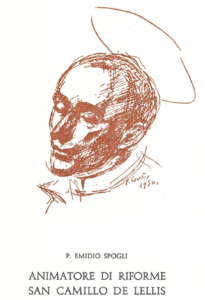A date, a turning point
In August 1582 Camillus de Lellis had the insight of creating a company of pious and good men to solve the grave problems that existed as regards care for the sick admitted to the Hospital of St. James for Incurables, of which he was appointed ‘House Master’, a title equivalent to financial administrator and head of personnel.
With this Company of the Servants of the Sick, which with this insight Camillus created with surprising rapidly, was born something that was really new in the hospitals of Rome, as well as the hope that there would not only be a return to the care for the sick of the shining traditions of the Christian community but also that advance which the new society to emerge from the Renaissance and new health-care situations required.
Indeed, the situation in Roman hospitals at the end of the sixteenth century had become unsustainable. Hospitals had been a glory of the Church of Rome and amongst them stood out, because of its history and importance, the Hospital of the Holy Spirit, which had been founded by Innocent III in 1198 and was defined as one of the greatest events of the world of the Middle Ages. In the year 1471 it was rebuilt and modernised with sumptuous magnificence by Sixtus IV so that it could continue to be Christianae caritatis gymnasium, a school of Christian charity, as one can still read today on an old plague located within the hospital.
But during the second part of the sixteenth century things were very different compared to the intentions of the Supreme Pontiffs. The glorious Hospitaller Order of the Holy Spirit, which had managed the hospital since its foundation and had acquired so much merit during the four centuries of its history, had, it appeared, to lower its flag.
Two Apostolic Visits, that is to say two ministerial inspections as we would call them today, made in 1574 and 1585, made some very severe findings about the friars themselves and even more about the people looking after the patients. Here are some of them:
‘The ward for the gravely ill and the schizophrenics is small and odorous and there is no assistant for the patients’.
‘In the rooms of the sick the sheets are changed only every fifteen days and we found that everything was very dirty’.
‘There is nobody to help the gravely ill to eat and the patients have their meals at inopportune hours and much before time, both in winter and in summer. The medical doctors visit them very hurriedly and very early in the morning or very late in the evening’.
These were not exaggerated findings. Indeed, we have another first-hand testimony of great authority, a memorial of Bernardino Cirillo who for more than two decades, from 1550 to 1574, was Knight of the Hospital of the Holy Spirit, that is to say the president of the hospital.
He spoke about a ‘very bad and abominable’ service, carried out by ‘devilish abnormal people and amongst them good is cursed, and if you speak they have a bad reaction or they leave you or they steal from you’.
It was a good idea to change them because often things went from bad to worse, and to ‘create there good things and make a seminary requires too much work and too many costs’. To pay them well was not useful. No payment was enough to convince these workers to ‘empty the urinals’ of the patients.















Camillians on Facebook
Camillians on Twitter
Camillians on Instagram